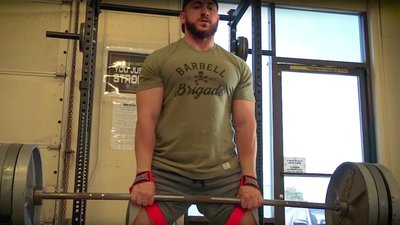When Silent Mike and Alan Thrall team up to show you how you need to change your deadlift, it's best to shut up and listen. These veteran lifting coaches have combined decades of lifting experience, plenty of heavy lifts under their belts, and are fully dedicated to helping lifters get stronger and avoid injury.
In this video, the duo tackles the infamous deadlift, an exercise whose bad reputation for lower back injury lead many to avoid it altogether. But not these two. Attacking this beast with humor and basic physics, these guys give you the tips you need to avoid common errors and build a bigger deadlift.
First Things First
The deadlift starting position is perhaps the most critical component of the entire lift. As Alan puts it, "Where you start is going to affect the entire pull." The correct starting position is with the barbell over the middle of your foot, and, in a quick and fun demonstration, Mike shows you exactly why this position makes the most sense.
Think of it this way: If you had to hold a very heavy barbell in a standing position for a long time, where would you want it to be? Definitely not over your toes or heels—you'd tip over like a tree in a storm. The middle of your foot is where your center of gravity is, and it's the shortest distance from the beginning to the end of the move.
Common positioning errors (like starting with the barbell too far out over your toes or shifting your weight too far back) add difficulty because they increase the total distance the bar travels. These poor positioning techniques also cause the barbell to swing once it breaks contact with the floor, creating even more work for you.
Hips Down, Back Tight
Requirements of a proper deadlift include tension in your hamstrings, a tight lower back, and keeping your weight behind the bar. Keeping the barbell over the middle of your foot and maintaining a straight line throughout the movement demands proper alignment of your hips and back.
If your hips shoot up too early in the deadlift, or you just don't have them in the right position to begin with, you won't get tension at the bottom of the exercise to lift the bar properly and it will seem much heavier than it is.
"You want to make sure you're deadlifting the bar and not trying to squat it," says Mike. "The further the bar creeps away from you, the heavier it gets."
Start with your hips down and your weight falling back. Mike recommends flexing your lats to stabilize your spine. To help get you in the right position, screw your shoulders in and imagine 'bending' the bar over your legs while turning your elbows back, closer to your hips. This keeps the barbell closer to your body and engages the muscles along your back that you need to safely move a heavy-ass bar.

Break Out of Beast Mode
As a competitive strongman, Alan is no stranger to colossal lifting. But, he's also seen firsthand that building monster strength is not about sacrificing proper technique to beat the bar.
"A huge mistake that I often see is people trying to go beast mode on the bar by just resorting to intensity, and their technique goes out the window," gripes Alan. "They bend their arms and they jerk on the bar as hard as they can. This is usually going to throw you out of position, it's going to cause some elbow problems, and you might pop a bicep."
To be clear, the deadlift is not an exercise that you can start with your arms alone, but when you abandon your steady and systematic setup for an amped-up and rushed one, that's exactly what you end up doing.
To fix overactive beast mode, Alan recommends pulling the slack out of the barbell by creating tension in your arms before lifting the bar off the floor. To make sure your arms are straight, Alan suggests flexing your triceps, or turning your elbows into your body.
"Try to squeeze the bar off the ground rather than jerk it off the ground as hard as you can," he says.
The Power of the Pause
Alan's favorite deadlift variation for reinforcing these tips and correcting technique is the pause deadlift, where you immediately pause after lifting the bar off the ground. Instead of wrenching the bar with force, you'll have to build tension before lifting and squeeze the weight off the ground slower than you might be used to. The pause deadlift also reinforces proper alignment because it is very difficult to hold the barbell anywhere but right over the middle of your foot.
To maintain the principles you've learned here and build a bigger deadlift, these guys recommend including this exercise in your training program by keeping one competition-style deadlift day, then adding another pause deadlift workout three days later. They suggest 3-4 sets of 3-8 reps, with 50-70% of your one-rep max weight for the pause day.


